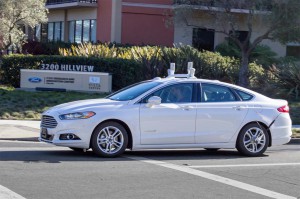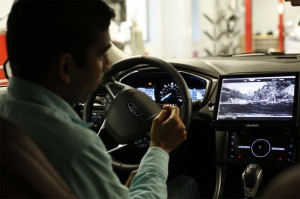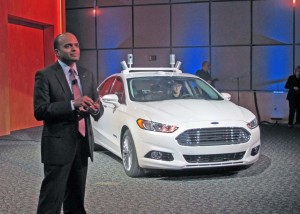It has become conventional wisdom within the transportation industry that the introduction of autonomous vehicles will be a step-by-step process, starting with so-called “driver assistance” systems and only eventually reaching the point where cars and trucks will be capable of driving entirely on their own.
Ford Motor Co. says it is heading in a very different direction, however, the Detroit automaker revealing plans to put its first completely driverless vehicle into production by 2021. The model it is working on, global product development chief Raj Nair tells TheDetroitBureau.com, won’t even have a steering wheel or pedals.
“We don’t think the path to true autonomy is through a step-by-step, incremental process,” Nair said during a telephone interview. Having a driver sit behind the wheel, waiting to take over in an emergency is actually a dangerous solution, he explained because, over time, “You lose driver awareness. You lose the ability for a human to respond in a timely manner.”
He’s not the only one worried about that problem. When a Tesla Model S running on Autopilot was involved in a fatal crash on May 9th, it failed to recognize a truck that had pulled into the battery sedan’s path. Driver Joshua Brown, a 40-year-old former Navy SEAL, may have been distracted, watching a video, according to some reports, and unable to respond in time.
Even in the airline industry, failures of automatic systems can go unnoticed. An Air France jetliner crashed into the ocean off Brazil when the crew failed to realize the autopilot system had malfunctioned. A Korean Air crash in San Francisco, two years ago, occurred when another system was inadvertently deactivated – and despite have a cockpit full of veteran pilots.
Until recently, Ford was following the same path as key rivals like Nissan and Daimler AG. The German maker’s new 2017 E-Class sedan offers an array of driver assistance systems that can even allow it to pass a slower vehicle on its own. Nissan plans to add a similar system, part of a series of incremental steps before producing its first, fully autonomous vehicle in 2020.
But even that goal has alarmed skeptics, such as California-based Consumer Watchdog, who feel the industry is moving too quickly.
It’s unclear how federal regulators will respond to Ford’s plan. National Highway Traffic Safety Administration chief Mark Rosekind is a big believer in autonomous technology, suggesting it could virtually eliminate U.S. highway deaths. Under his guidance, the agency plans to release its first self-driving vehicle guidelines by the end of this summer. But it was expected to enshrine the step-by-step approach.
(Carmakers enter “gray zone” as they roll out semi-autonomous technology. Click Here for the full story.)
In California, home of Tesla and Google, the tech giant many consider to be a leader in the race to autonomous driving, regulators have taken steps to restrict testing fully driverless vehicles on public roads – something that Google had hoped to begin in the near future.
“We’d love to see a national policy,” said Nair. “It would certainly be a detriment to have a patchwork of statewide regulations.”
Whether California will become a roadblock remains to be seen, but Ford plans to make Silicon Valley the center of its autonomous vehicle research program. It will soon triple the size of the facility it only opened this past year, Nair revealed, while doubling its staff.
The maker has also launched strategic initiatives with four high-tech startups:
- Velodyne, a Silicon Valley firm developing new LIDAR, or light detection and ranging sensors, needed to provide autonomous vehicles a high-definition, 3D view of the world;
- SAIPS, an Israeli computer vision and machine learning company;
- Nirenberg Neuroscience, a company developing ways for machines to see the world much like humans do; and
- Civil Maps, a Berkeley, California tech firm that has pioneered 3D mapping.
From a technical standpoint, Ford is taking a more complex approach to autonomy than key rivals opting for a combination mediated/direct perception system. That’s a fancy way of saying its driverless vehicles will use onboard maps that show every road in extremely fine detail, down to signposts and potholes. The map data will be constantly compared to the real-time images gathered by the vehicle’s LIDAR, radar and cameras so it can monitor traffic and spot temporary obstacles, such as construction barrels.
Significantly, Ford plans to first market its driverless vehicles to ride-sharing services, as well as package delivery companies. That should make Travis Kalanick happy. The CEO of Uber has set a goal of switching to driverless vehicles and has even launched the company’s own research center in Pittsburgh.
(Tesla plans to make its Autopilot more robust to avoid further problems. Click Here for the latest.)
Nair declined to say if Ford is discussing its driverless vehicle plans with Uber or any other possible fleet customer. But the appeal should be strong.
While the Ford exec acknowledged there will be a steep premium for a driverless vehicle, “if you look at the ride hailing service business structure, the highest cost is the driver. So,“ added Nair, “it makes a lot of business sense if you can automate (out) the driver.”
Some studies, from firms like Britain’s Juniper Research, and the Boston Consulting Group, have estimated that with a fleet of fully autonomous vehicles, the Ubers and Lyfts of the world will be able to offer on-demand rides for less than what it costs to own and operate a personal automobile.
The potential downside is that this could lead many motorists to either abandon, or at least reduce the size of, the household vehicle fleet. But Nair said Ford is confident there will still be a strong vehicle market if you factor in those ride-sharing fleets.
Ford’s announcement has taken many in the industry by surprise. The maker was, until recently, considered a bit of a laggard in autonomous vehicle research. Ford was simply keeping quiet, explained Nair.
It’s too early to determine whether its announcement will serve as an industry game-changer or just offer another possible scenario. But it does add to the momentum as automakers around the world race to put autonomous vehicles on the road.
(GM reportedly wants to buy Lyft. Click Here for more.)




